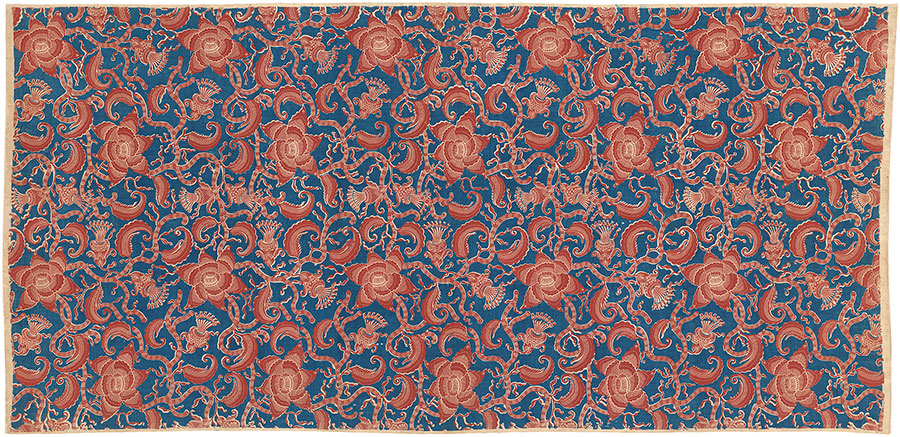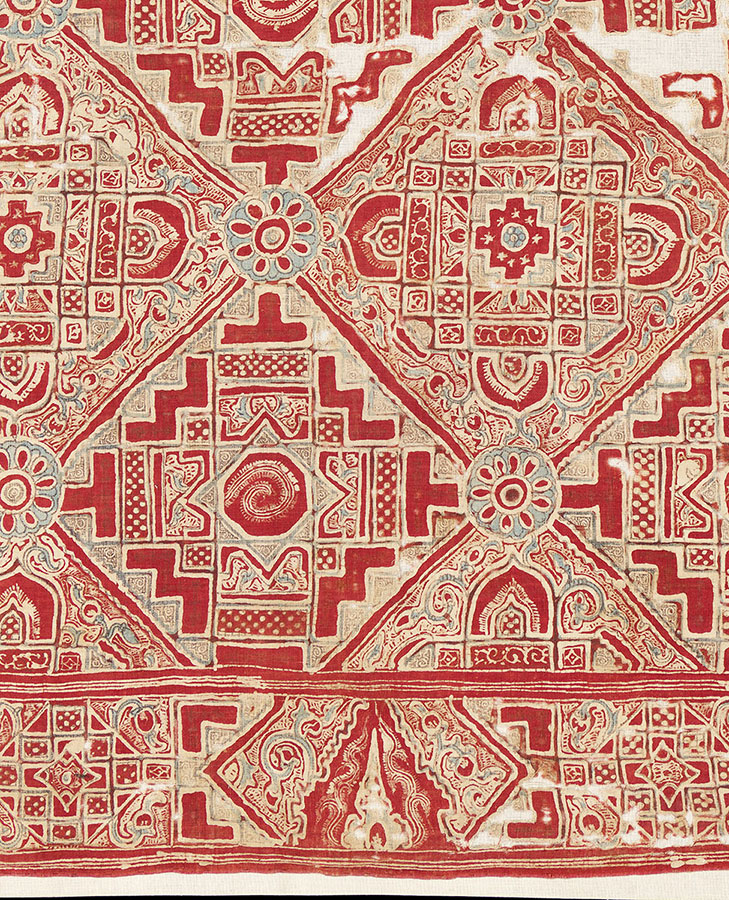
Indian Trade Cloth with “High Baroque” motif, India, found in Indonesia, cotton; mordant red on an indigo ground, likely 18th Century, 90 x 44 in / 229 x 112 cm, Thomas Murray
We are pleased to share the second installment of additional material related to our recent webinar on art conservation which featured scholarly contributions from two leading Asian Art conservators, Leslie Gat, (Art Conservation Group) and John Twilley (Art Conservation Scientist), along with AWNY members Mary Ann Rogers (Kaikodo LLC), and Thomas Murray (Thomas Murray Asian and Tribal Art).
Some questions and answers relating to conservation in general and to textiles in particular:
1. How do you decide on the degree of restoration to perform?
The basic guide for visual integration of damages is that when you are close to the object, you should be able to tell the difference between original and restorative materials. If not visible to the naked eye, it should be visible under a raking light or a UV light source. It is a balancing act. The goal is to make the piece visually appealing without burying the authenticity of the piece under cosmetics.
Your question raises two issues for conservators beyond the overall esthetics of the piece – the materials used and extent of restoration.
The guiding principle for conservators is that, as much as possible, all materials used during treatments must be reversible. Generally, a fill material would be one different from the original. On a Mayan Jar, a reversible synthetic putty or plaster or a vinyl spackle or a combination of these might be used. The material itself would be pigmented or the fill surface would be inpainted once it was dried and shaped. All restorative materials would be in the areas of damage only, extant original surfaces would be left untouched.
The extent of loss compensation for a stable object is a subjective decision, often guided by styles of the present day and can be very different for objects from different periods and cultures. There are countless examples of work done only 20 years ago that would be approached in very differently now. And the same will be true in 20 years for the work we do now, which is one of the reasons why it is so important for us to make what we do reversible.
At the present time, best practices in the field hold that the goal is to make an object’s original intent legible and to do so in a manner that minimizes the visual effect of the both the loss and restorative intervention without doing irreversible damage to the object.

Indian Trade Cloth with “Thai Temple” motif (detail), Coramandel Coast, found in Indonesia, cotton; hand painted mordant red and indigo, 17th Century, 35 x 49 in / 89 x 124 cm, Thomas Murray
2. Do you have any advice about storage packing material for antique wood, lacquer and textiles? Is bubble wrap outside of acid free paper to be avoided?
The climate – relative humidity (RH%) and temperature – is the most important consideration for storage.
Wood and lacquer are usually stored in 50 – 55% relative humidity. Textiles should be ok in 50±5%. Note that these are generalized recommendations and objects can have individual idiosyncrasies that would need to be taken into consideration.
As a general rule, fine art and cultural materials/objects should not be stored in any type of plastic wrap. A sealed environment should only be used if RH% controls appropriate to the materials can be maintained within the sealed package.
Archival boxes with unbuffered acid free tissue are good basic materials for most storage needs. It is often helpful to attach a photograph of the enclosed materials for later reference without having to open the box.
3. Is it safe to freeze all kinds of textiles for pest control?
Deep freezing is a widely practiced pest eradication approach in museums and involves placing individually packaged objects in a deep freezer at -20˚ to 30˚C (depending on which studies you read) for about 24 hours. The object is then removed, allowed to thaw and then refrozen at the same temperatures for another week or two (studies vary). Since most household freezers do not reach those temperatures, it is not really possible to guarantee that a household treatment will be successful, unless of course, the collector has a deep freezer.
For collectors with moth infestations, I would recommend contacting a conservator in their area. When there is one moth infestation, it is possible that other objects are also infested and object handling varies depending on a pieces age and fragility.
The AIC lists some conservators in private practice on their website:
https://www.culturalheritage.org/about-conservation/find-a-conservator
One of the attendees, Vera Indenbaum, provided a link to her blog on Textile Care Recommendations, where a number of questions raised are answered here.
This post is part one of a three part essay about our Webinar, Tales in Conservation. To read part one Click here.
Watch an excerpt from the Tales in Conservation webinar:
